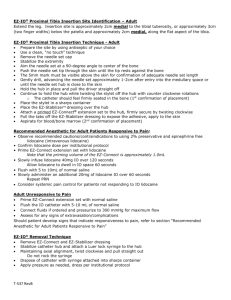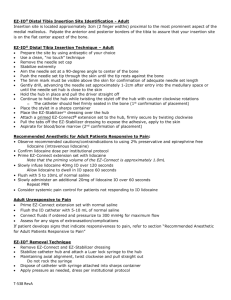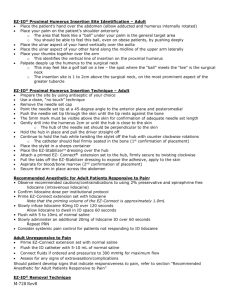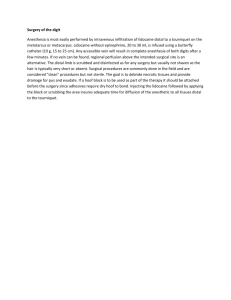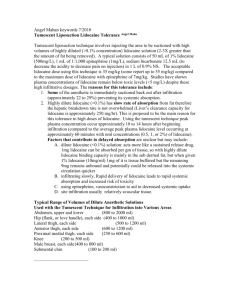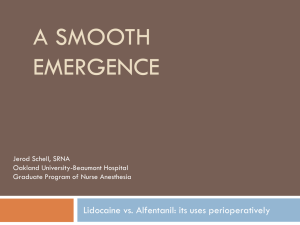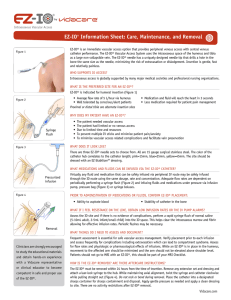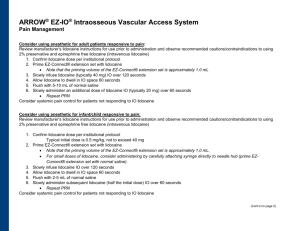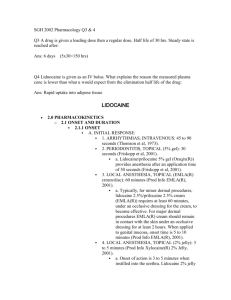Recommended anesthetic for adult patients responsive to pain
advertisement
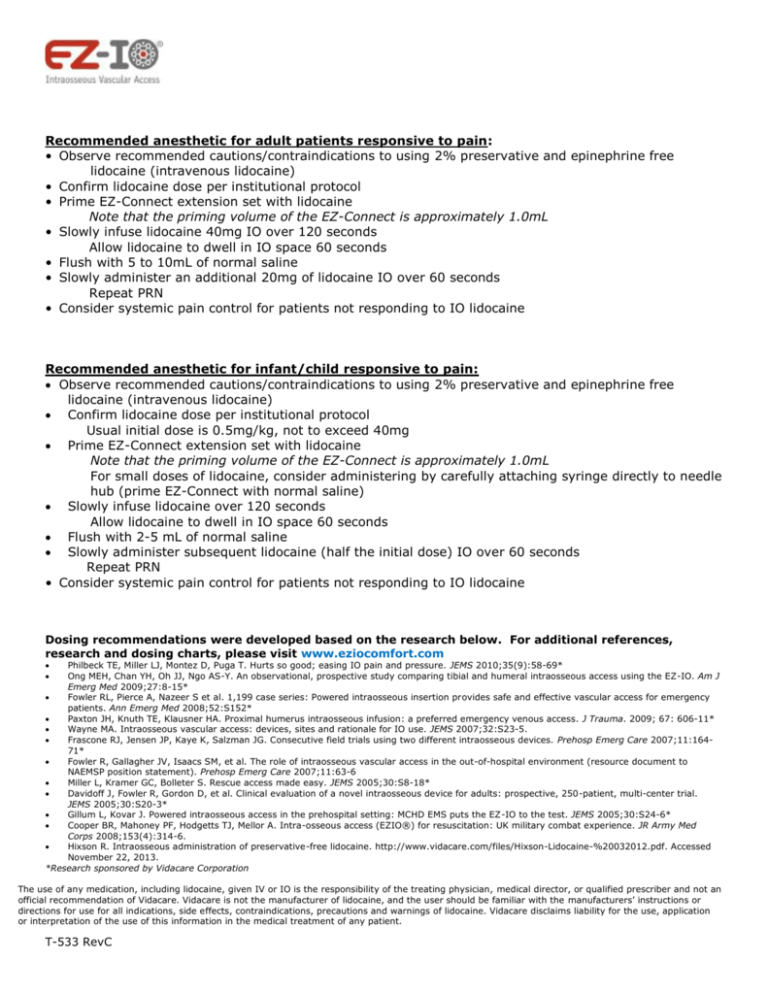
Recommended anesthetic for adult patients responsive to pain: • Observe recommended cautions/contraindications to using 2% preservative and epinephrine free lidocaine (intravenous lidocaine) • Confirm lidocaine dose per institutional protocol • Prime EZ-Connect extension set with lidocaine Note that the priming volume of the EZ-Connect is approximately 1.0mL • Slowly infuse lidocaine 40mg IO over 120 seconds Allow lidocaine to dwell in IO space 60 seconds • Flush with 5 to 10mL of normal saline • Slowly administer an additional 20mg of lidocaine IO over 60 seconds Repeat PRN • Consider systemic pain control for patients not responding to IO lidocaine Recommended anesthetic for infant/child responsive to pain: Observe recommended cautions/contraindications to using 2% preservative and epinephrine free lidocaine (intravenous lidocaine) Confirm lidocaine dose per institutional protocol Usual initial dose is 0.5mg/kg, not to exceed 40mg Prime EZ-Connect extension set with lidocaine Note that the priming volume of the EZ-Connect is approximately 1.0mL For small doses of lidocaine, consider administering by carefully attaching syringe directly to needle hub (prime EZ-Connect with normal saline) Slowly infuse lidocaine over 120 seconds Allow lidocaine to dwell in IO space 60 seconds Flush with 2-5 mL of normal saline Slowly administer subsequent lidocaine (half the initial dose) IO over 60 seconds Repeat PRN • Consider systemic pain control for patients not responding to IO lidocaine Dosing recommendations were developed based on the research below. For additional references, research and dosing charts, please visit www.eziocomfort.com Philbeck TE, Miller LJ, Montez D, Puga T. Hurts so good; easing IO pain and pressure. JEMS 2010;35(9):58-69* Ong MEH, Chan YH, Oh JJ, Ngo AS-Y. An observational, prospective study comparing tibial and humeral intraosseous access using the EZ-IO. Am J Emerg Med 2009;27:8-15* Fowler RL, Pierce A, Nazeer S et al. 1,199 case series: Powered intraosseous insertion provides safe and effective vascular access for emergency patients. Ann Emerg Med 2008;52:S152* Paxton JH, Knuth TE, Klausner HA. Proximal humerus intraosseous infusion: a preferred emergency venous access. J Trauma. 2009; 67: 606-11* Wayne MA. Intraosseous vascular access: devices, sites and rationale for IO use. JEMS 2007;32:S23-5. Frascone RJ, Jensen JP, Kaye K, Salzman JG. Consecutive field trials using two different intraosseous devices. Prehosp Emerg Care 2007;11:16471* Fowler R, Gallagher JV, Isaacs SM, et al. The role of intraosseous vascular access in the out-of-hospital environment (resource document to NAEMSP position statement). Prehosp Emerg Care 2007;11:63-6 Miller L, Kramer GC, Bolleter S. Rescue access made easy. JEMS 2005;30:S8-18* Davidoff J, Fowler R, Gordon D, et al. Clinical evaluation of a novel intraosseous device for adults: prospective, 250-patient, multi-center trial. JEMS 2005;30:S20-3* Gillum L, Kovar J. Powered intraosseous access in the prehospital setting: MCHD EMS puts the EZ-IO to the test. JEMS 2005;30:S24-6* Cooper BR, Mahoney PF, Hodgetts TJ, Mellor A. Intra-osseous access (EZIO®) for resuscitation: UK military combat experience. JR Army Med Corps 2008;153(4):314-6. Hixson R. Intraosseous administration of preservative-free lidocaine. http://www.vidacare.com/files/Hixson-Lidocaine-%20032012.pdf. Accessed November 22, 2013. *Research sponsored by Vidacare Corporation The use of any medication, including lidocaine, given IV or IO is the responsibility of the treating physician, medical director, or qualified prescriber and not an official recommendation of Vidacare. Vidacare is not the manufacturer of lidocaine, and the user should be familiar with the manufacturers’ instructions or directions for use for all indications, side effects, contraindications, precautions and warnings of lidocaine. Vidacare disclaims liability for the use, application or interpretation of the use of this information in the medical treatment of any patient. T-533 RevC
